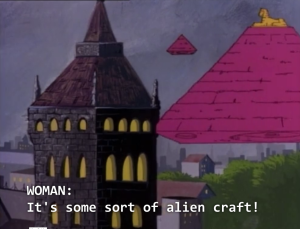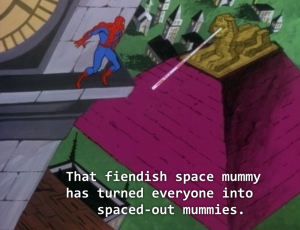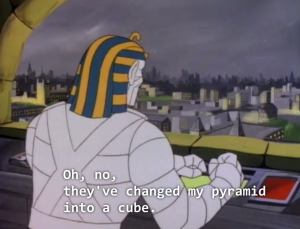 If, like me, you grew up in the United States at a certain time (I’m guessing any time after the 1960s), you read a lot of Hardy Boys books (or their female-targeted equivalent, Nancy Drew). Every school library, and every public library with a section aimed at young people, seemed to have a complete set of these, in this hardback library binding with a sort of hatched, grainy cover texture.
If, like me, you grew up in the United States at a certain time (I’m guessing any time after the 1960s), you read a lot of Hardy Boys books (or their female-targeted equivalent, Nancy Drew). Every school library, and every public library with a section aimed at young people, seemed to have a complete set of these, in this hardback library binding with a sort of hatched, grainy cover texture.
I didn’t know these books existed in the UK, so imagine my surprise to find over a dozen of them on the “take a free book” shelf at the station while I was waiting for a coach. Not, sadly, in this classic format, but in a more modern one.
Also, good God, looking on the internet tells me that these things have been being published since 1927 and there was an attempt to modernise the franchise using the name “the Clues Brothers,” which is just unforgivable but strangely appealing.
Anyway, where was I? I was going to just enjoy a moment of nostalgia until I saw that one of these was about a Viking runestone, at which point I snapped it up and took it with me, regardless of the fact that it was supposed to be for a) commuters and b) little kids. I’ll put it back when I’m done, promise.
For those of you unfamiliar with the premise of the Hardy Boys, you have these two brothers, Frank and Joe Hardy, and their squad of teenage chums (the Fat One, the Ethnic One and the Other One) who solve mysteries under the mentorship of private eye father Somebody Else Hardy. The whole thing is sort of breathlessly innocent and stupidly didactic, in a way that I totally failed to notice when I was young but which is now very charming to read. Here’s an example, from a scene in which the brothers are searching a dump for clues:
When they met there, neither boy had found a clue.
Joe looked glum. “Guess we’re just out of luck,” he said, kicking an old box.
His brother was about to agree, when the box turned over and out fell a rolled-up pair of grey slacks. Both boys grabbed for the box and Frank pulled out a black-and-white checked sports jacket.
“Wa-hoo!” Frank exulted, holding up the jacket and turning it inside out. “Look at this label — Toronto, Canada!”
“The slacks are from Quebec,” Joe said, looking puzzled. “Do you think Kelly is from Canada?”
“He could be,” Frank answered, greatly excited.
Now, there is no form of humour lower and more predictable than the American making fun of Canada for being mostly like America but slightly different in some ways — they say “eh!” They’re very polite! They like hockey! — but it is impossible not to get a bit of a smile out of how much time our heroes spend being amazingly excited about going to Canada.
In a way, it’s part of the silly charm of the book, and it’s indicative of a certain kind of adventure story that is just no longer around, or at least not from a casual observer’s perspective. The aspects of adventure that turn up in this yarn are very pragmatic things: learning to fly a floatplane, trekking through the wilderness, a run-in with a dangerous animal. All that kind of stuff that appears to have been super-exciting to the youth of another day but which has been replaced by magic and monsters in most modern children’s fiction. (He said, as if he knew anything about it.)
And in a way that’s pretty understandable — I mean, there’s a scene in this book where the brothers and The Fat One get a tour of Saskatoon. Saska-fuckin-toon, I mean, it’s not exactly Hogwart’s. But on the other hand, it’s a little sad, because young readers are never going to get to go to Hogwarts, but they could conceivably learn to fly a plane. Anyway, I dunno. Let’s get back to the story.
So where does the Viking stone come in? I’ll let Mr Hardy explain:
“A few days ago,” Mr Hardy explained, “I had a telegram from a Mr Black, who is curator of London Museum in England. Because I had been successful in solving a case in Canada a few years ago, I had been recommended to Mr Black.”
“Yes?” Joe prompted.
“This mystery,” his father went on, “concerns an invaluable Viking rune stone that was stolen recently in Edmonton, Alberta.”
“Wow!” exclaimed Joe. “That’s near the edge of the Northwest Territories.”
“Those old Scandinavian mariners really covered a lot of water in their far-flung travels,” said his father, “often ranging inland for great distances. The runic alphabet was copied from Latin and Greek letters by the Teutonic peoples about the third century.”
Thanks, Mr Hardy!
Now, it soon transpires that this stone is no ordinary stone, heck no, but in fact contains some clues that will lead its reader to, you guessed it, hidden treasure. So the brothers are off to Canada.
Obviously, this Canadian runestone recalls the Kensington runestone, a forgery from 19th-century America (although no one who talks about the Kensington runestone ever mentions that it doesn’t even claim to be Viking — it claims to be from the 14th century).
So off they go to Canada, where they run into:
-
Grain elevators!
- A big bearded French-Canadian trapper in a checked shirt who says Bon tonnere! every third sentence!
- The Mounties!
- Bears!
And they find a rune stone, but:
A look of disappointment spread over the Englishman’s face.
“This stone is not authentic,” he said wearily, but with certainty. “I can tell by the sharp edges of the lines that it was not carved in the ninth century. It is a rather clever imitation.”
But never fear — this is just a duplicate crafted by the thieves to throw the Hardys off the scent. The real runestone reveals the location of a sunken Viking ship near Yellowknife, full of tray-zher.
Reaching deep into a sack, Chet pulled out a handful of glittering gold coins.
“Wow! Look at these!” he cried.
“And this statue must be worth a fortune!” Frank held up the gold figure of a Viking warrior.
“This is a historical find, as well as a valuable one,” Mr Hardy said. “It definitely links the exploration of northern Canada to the ancient Norsemen.”
Aaaaaand then the story is explained and our heroes eat a bison and we’re done.
There are a surprising number of these books that seem to have some kind of archaeological content, but it’s not so surprising when you consider their need to combine good old-fashioned adventure with some kind of “educational” content, or at least as educational as a hack writing under a house name with a public library reference book at his elbow could crank out. Chasing historical artefacts lets you graft a history lesson onto your adventure story (and not subtly, either; check out that quote up top from Mr Hardy) with minimal fuss.
I don’t know why I find the earnest corniness of this kind of story so appealing, but I do.




























